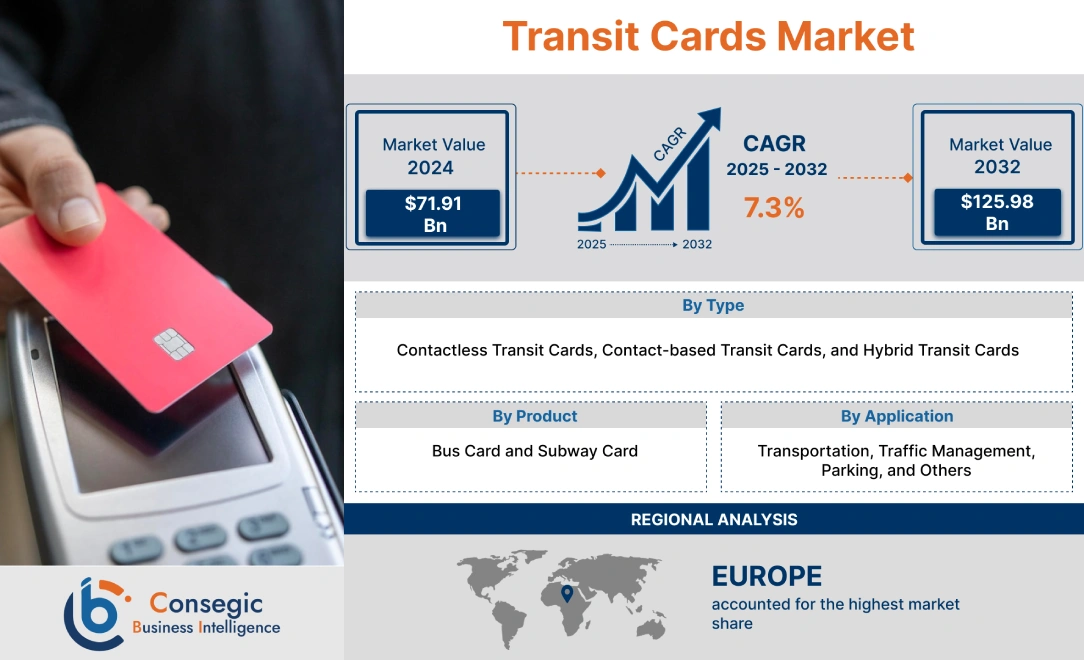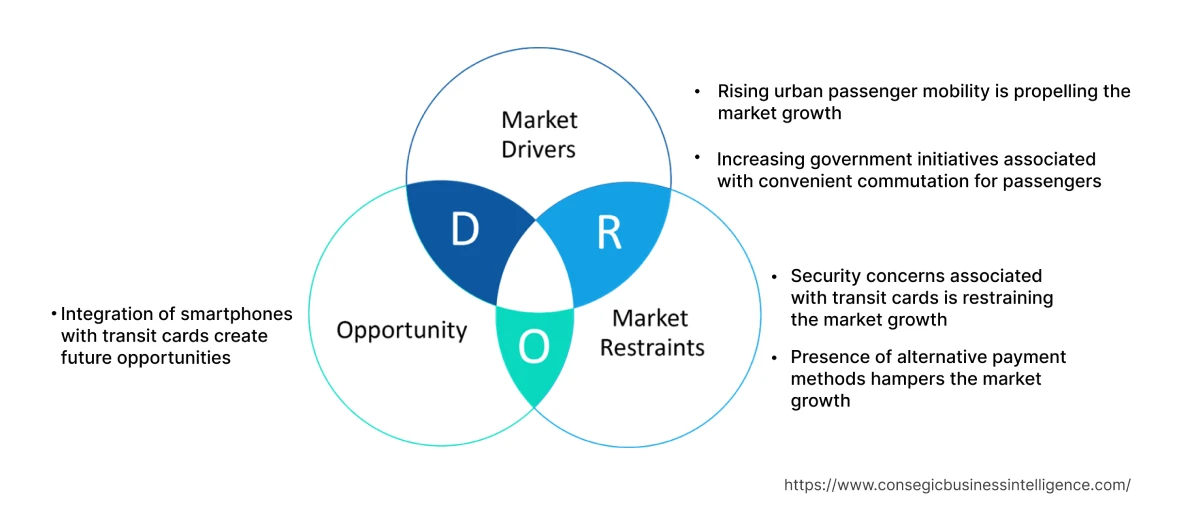- Summary
- Table Of Content
- Methodology
Transit Cards Market Introduction :
Transit Cards Market is estimated to reach over USD 125.98 Billion by 2032 from a value of USD 71.91 Billion in 2024, growing at a CAGR of 7.3% from 2025 to 2032.
Transit Cards Market Definition & Overview:
A transit card is a smart card, utilized to make payments for public transportation services, namely buses, trains, and subways. The cards are designed to be recharged at regular intervals, through a ticket vending machine, and scanned at the point of entry to the transportation service. The fare for the trip is automatically deducted from the balance on the card, and the remaining balance is displayed on the screen. In addition, transit cards are also utilized to pay for other services, including parking, and to store user information, including personal identification.
Transit Cards Market Insights :
Key Drivers :
Rising urban passenger mobility is propelling the market growth
The primary factor responsible for the growth of the transit card market is the rising passenger mobility, particularly at subway stations. The surge in the number of passengers traveling by metro or train increases the demand for transit cards to offer convenience to users by eliminating the need to purchase tickets. The cards are recharged online and scanned at the point of entry to the transportation service, thus excluding the need to stand in long queues. Consequently, the benefits offered by transit cards including streamlining the ticket buying process by preventing time delays are contributing remarkably in driving the growth of the global transit cards market. For instance, in November 2021, Paytm launched an all-in-one transit card to pay for buses, metros, trains, and parking. The card is designed to offer convenience to passengers, thus contributing appreciably in promoting the market growth.
Increasing government initiatives associated with convenient commutation for passengers
The increase in the government initiatives to enhance the passengers' traveling experience acts as the major driver for the growth of the transit cards market. The government is investing heavily to upgrade the infrastructure by launching transit cards to improve the ticket purchasing process. Various governments are introducing transit cards to offer convenience to users, thus contributing notably in promoting the growth of the transit cards market. For instance, in May 2023, the Ontario government launched PRESTO, a transit card to improve the passenger's travelling experience. PRESTO has approximately 4.7 million active customers, hence, contributing significantly in fueling the growth of the transit cards market.
Key Restraints :
Security concerns associated with transit cards is restraining the market growth
The security concerns associated with transit cards, including the loss of customer's sensitive financial information serve as the major factor restraining the growth of the transit cards market. Transit card providers are obliged to comply with certain legal and regulatory requirements related to data privacy, security, and fraud prevention. The above-mentioned requirements generate additional compliance cost and administrative tax on transit card providers, limiting the growth of the market. Consequently, security concerns and strict government regulations are the primary factors restraining the growth of the market. For instance, in January 2022, PCI Security Standards Council, LLC updated the provisional security standard by implementing the installation of security requirements version 3.0. to protect sensitive data. The implementation of such regulations is hindering the growth of the transit card market.
Presence of alternative payment methods hampers the market growth
The presence of alternative payment methods including mobile payments and digital wallets serves as major factors in hampering the growth of the transit cards market. The ability of mobile payments to offer a high degree of convenience to users by processing payments quickly and easily using smartphones is restraining the growth of the transit card market. In addition, digital wallets offer robust security features, namely biometric authentication, and encryption, to protect user information and reduce the risk of fraud. In conclusion, the ability of alternative payment technologies to provide improved safety and convenience is contributing significantly in restraining the growth of the transit cards market.
Future Opportunities :
Integration of smartphones with transit cards create future opportunities
The integration of smartphones with transit cards is projected to create several opportunities for market growth in the transit card industry. The integration offers more convenient and streamlined experience to users with an additional security feature, namely biometric authentication to reduce the risk of fraud. Furthermore, the integration also provides transit card providers with valuable data on user behavior and preferences to improve services, personalize offerings, and develop targeted marketing campaigns. In conclusion, the integrated approach is expected to create potential opportunities by improving the customer experience along with offering valuable data insights. For instance, in March 2023, The Connecticut Department of Transportation (CTDOT) launched a new pilot program in partnership with Token Transit to enable citizens to book the bus tickets on smartphones. The program was launched to offer convenience to senior citizens to book tickets, hence is expected to create opportunities for market growth.
Transit Cards Market Report Insights :
| Report Attributes | Report Details |
| Study Timeline | 2019-2032 |
| Market Size in 2032 | USD 125.98 Billion |
| CAGR (2025-2032) | 7.3% |
| By Type | Contactless Transit Cards, Contact-based Transit Cards, and Hybrid Transit Cards |
| By Product | Bus Card and Subway Card |
| By Application | Transportation, Traffic Management, Parking, and Others |
| By Region | Asia-Pacific, Europe, North America, Latin America, Middle East & Africa |
| Key Players | 4G Identity Solutions Private Ltd. (Goldstone Technologies Ltd.), Beijing Watchdata Co. Ltd., Cardlogix Corporation, Capital Metropolitan Transportation Authority, Eastcompeace Technology Co. Ltd, Entrust Corporation, Giesecke & Devrient GmbH, Infineon Technologies AG, Mastercard Inc., Thales Group, Watchdata Group |
Transit Cards Market Segmental Analysis :
Based on the Type :
The type segment is trifurcated into contactless transit cards, contact-based transit cards, and hybrid transit cards. Contactless transit cards accounted for the largest market share in 2024 and is also projected to witness the fastest CAGR during the forecast period. The growth of the market is endorsed by the advancements in technology including EMV technology (Europay, Mastercard, and Visa) to offer improved security of payment card transactions by using a chip embedded in transit cards. In addition, contactless transit cards have a plastic coating to offer durability and are highly accurate in calculating ticket fares. Subsequently, the aforementioned factors including enhanced durability, accuracy, and security are collectively contributing in boosting the growth of the transit cards market. For instance, in February 2022, Krungthai Bank and the Mass Rapid Transit Authority of Thailand partnered with Mastercard to introduce a contactless transit card for metropolitan rapid transit. The product is designed utilizing advanced EMW technology to enhance the security of transactions, hence contributing notably in promoting the growth of the transit cards market.
Based on the Product :
The product segment is bifurcated into bus cards and subway cards. Subway cards accounted for the largest market share in 2024 as subways serve as the fastest mode of transportation for commuters to travel from one location to another. Transit cards offer seamless payment and additional benefits to customers for rail travel including surplus discounts, accelerating the growth of the market. In addition, the ability of transit cards to streamline the commuter traveling experience to avoid waiting in long queues further promotes the growth of the market. In conclusion, the expanding subway sector coupled with the aforementioned benefits offered by the transit cards are majorly responsible for bolstering the growth of the market. For instance, in March 2023, HDFC Bank collaborated with Indian Railway Catering and Tourism Corporation Ltd. (IRCTC) to launch a transit card to offer convenience to passengers traveling by Indian railways. The card offers several additional benefits to commuters including joining bonus points and discounts hence, contributing notably in fueling the growth of the transit cards market.
Bus stations are predicted to register the fastest CAGR in the transit cards market during the forecast period. The growth of the market is credited to the advancements in technology such as the emergence of the AFC system that collects transportation data to estimate destination matrices. In addition, the transit cards offer accessibility, particularly to elderly people to scan the card by simply placing it on the scanning screen. Consequently, the advancements in technology and the capability of transit cards to offer enhanced benefits, particularly to senior citizens, are projected to drive the market growth in upcoming years.
Based on the Application :
The application segment is categorized into transportation, traffic management, parking, and others. The transportation sector accounted for the largest market share of 32.89% in 2024 owing to the increasing urban passenger mobility at subway stations and bus stations. The surge in the number of passengers leads to passenger traffic at boarding stations resulting in long queues for buying tickets. The emergence of advanced contactless transit cards creates a more convenient and pleasant experience for passengers by reducing waiting time and paper ticket usage. Consequently, the increasing urban passenger mobility and the emergence of advanced contactless transit cards are the major factors responsible for propelling the growth of the market. For instance, in September 2022, Mastercard partnered with Finaro and Fertagus to launch a contactless transit card for railway applications in Lisbon. The card is introduced to offer convenience to more than 90,000 passengers who use the suburban trains between the South Bank and Lisbon.
The traffic management system is projected to witness the fastest CAGR in the transit cards market during the forecast period. Transit cards assist in reducing passenger congestion at bus stops and railway stations and streamline the ticket-purchasing process. Additionally, transit cards also provide real-time passenger data including passenger ticket number and boarding patterns. The data collected is utilized by transport operators to optimize the routes and schedules, thus resulting in reduced traffic congestion and improving the efficiency of the traffic management system. In conclusion, the ability of transit cards to provide real-time data to transport operators is expected to drive the market growth in upcoming years.
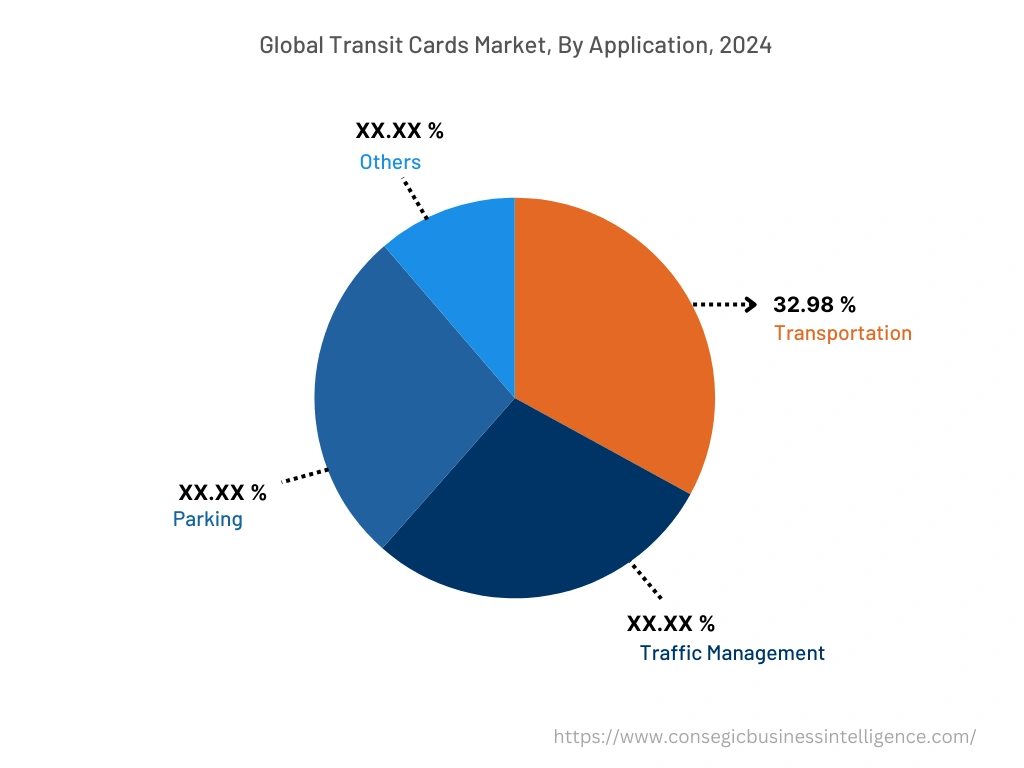
Based on the Region :
The regional segment includes North America, Europe, Asia Pacific, Middle East and Africa, and Latin America.
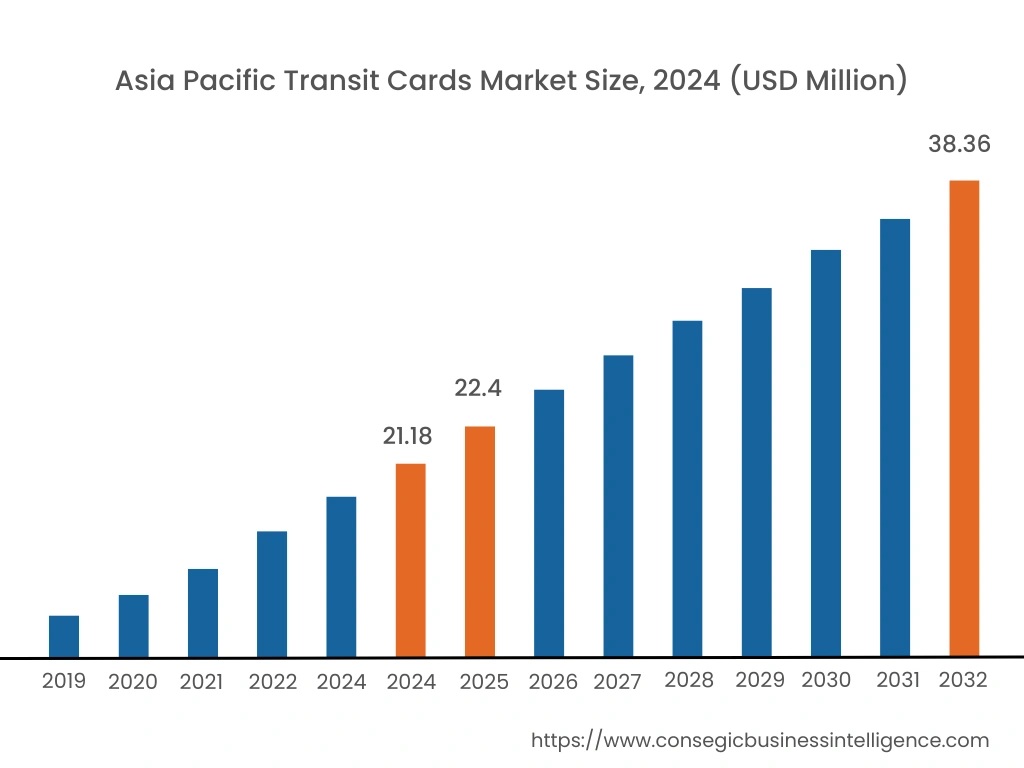
Europe accounted for the largest revenue share in 2024. The growth is attributed to the increasing adoption of contactless technology and the shift in the urban commuter mindset. Additionally, the region has a vast network of transportation including railways and buses that further drives the market growth by reducing passenger queuing time at ticket counters, hence offering convenience to passengers. For instance, in 7 April 2022, according to Statistisches Bundesamt, approximately 7.88 billion passengers in Germany traveled by trains and buses in 2021 showcasing a rise of 4% in comparison to 2020. The rise in the number of passengers traveling by trains and buses increases the demand for transit cards which in turn promotes market growth.
Moreover, increasing investments by the government in improving the public transport infrastructure also contributes considerably in accelerating the market growth. Consequently, the expanding railway sector, adoption of advanced technologies, and increasing investment by the government are the key factors responsible for driving the growth of the transit cards market in the region. For instance, in 20 July 2022, according to HM Treasury, the United Kingdom government spent almost USD 8.6 Billion to improve the local public transport infrastructure including the installation of ticket vending machines, high-quality display boards, and transit card-based contactless payments. The increasing government investments in enhancing the public transport infrastructure, thus act as a major factor in promoting the growth of the market.
Asia Pacific was valued at USD 21.18 billion in 2024 and is projected to reach USD 38.36 billion by 2032 with growing CAGR of 7.6% during 2025 to 2032. In addition, in the region, China accounted for the maximum revenue share of 26.7% in the year 2024. The growth in the region is attributed to the increasing investment in upgrading the infrastructure in countries namely China, India, and Japan. In addition, the rising demand for public transportation and surge in the train passengers is expected to fuel the market growth in upcoming years. For instance, in August 2022, according to the Philippine National Railways, the total number of travelers carried by the Philippine National Railways accounted to 3.8 million in 2021, and the majority of the passengers were carried by the Metro South commuter service. Consequently, the expansion in the transportation industry is projected to drive the market growth in Asia Pacific countries in upcoming years.
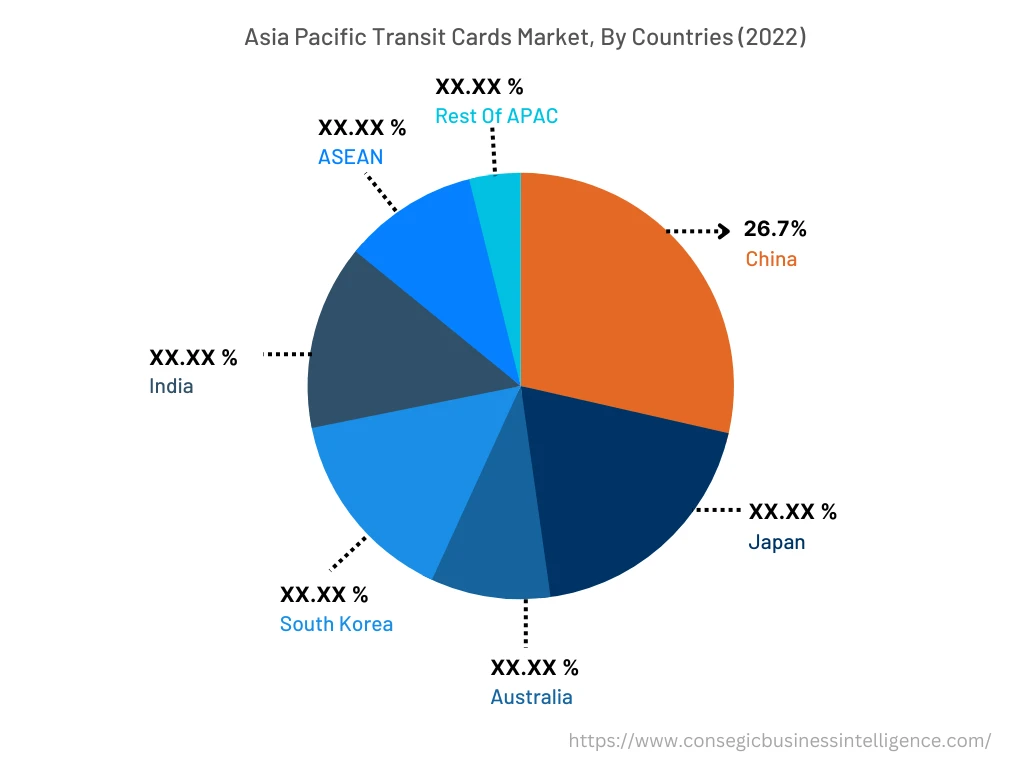
Top Key Players & Market Share Insights:
The landscape of the Transit Cards market is highly competitive and has been examined in the report, along with complete profiles of the key players operating in the industry. In addition, the surge in innovations, acquisitions, mergers, and partnerships has further accelerated the growth of the transit card market. Major players in the market include -
- 4G Identity Solutions Private Ltd.
- Beijing Watchdata Co. Ltd.
- Cardlogix Corporation
- Capital Metropolitan Transportation Authority
- Eastcompeace Technology Co. Ltd
- Entrust Corporation
- Giesecke & Devrient GmbH
- Infineon Technologies AG
- Mastercard Inc.
- Thales Group
- Watchdata Group
Recent Industry Developments :
- In February 2023, Mastercard collaborated with Network International – Jordan and Greater Amman Municipality (GAM) to roll out the first transit payment system in Jordan. The partnership is considered as a strategic decision by Mastercard to establish a partnership with the government and key companies to expand its digital payment portfolio in the international market.
- In September 2020, CapMetro launched a comprehensive fare collection system using a contactless transit card to offer convenience to passengers by providing a fast, reliable, and safe payment solution.
Key Questions Answered in the Report
What is Transit Cards? +
A transit card is referred to as a smart card, employed to make payments for public transportation services, including buses, trains, and subways.
What specific segmentation details are covered in the transit cards market report, and how is the dominating segment impacting the market growth? +
The report consists of segments including type, product, application, and region. Each segment has a key dominating sub-segment being driven by industry trends and market dynamics. For instance, the product segment has witnessed subways as the dominating segment in the year 2022, driven by the ability of transit cards to streamline the commuter traveling experience by eliminating the need to stand in long queues at subway stations.
What specific segmentation details are covered in the transit cards market report, and how is the fastest segment anticipated to impact the market growth? +
The report consists of segments including type, product, application, and region. Each segment is projected to have the fastest-growing sub-segment driven by industry trends and drivers. For instance, in the application, the traffic management sub-segment is anticipated to witness the fastest CAGR growth during the forecast period. The growth is attributed to the ability of transit cards to provide real-time passenger data including passenger numbers and boarding patterns to transport operators.
Which region is anticipated to witness the highest CAGR during the forecast period, 2025-2032? +
Asia Pacific is anticipated to witness the fastest CAGR during the forecast period due to the increasing investment in upgrading the infrastructure and the rising demand for public transportation.
